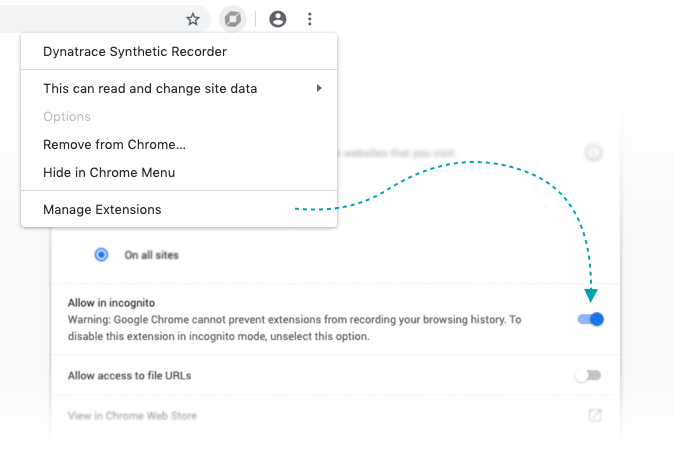With the release of Dynatrace version 1.174, the Dynatrace Synthetic Recorder Chrome extension now requires the Allow in incognito permission to record and play back clickpaths locally. This change will improve the quality of clickpath recordings and ensure that each clickpath is executed in the same way across all synthetic locations.
We’re constantly working on improving the Dynatrace Synthetic Recorder to make the recording of synthetic clickpaths as easy and stable as possible. One of the main concepts of synthetic monitoring is the provision of a “clean room” environment so that each synthetic monitor is executed with a clean browser state. Therefore, it’s important to provide this clean state during the recording phase itself.
Until now, the Dynatrace Synthetic Recorder saved the current cookie state, cleared it during recording, and restored it thereafter. Internally, we called this functionality “Cookie Monster” (🍪👻). This worked quite well for cookies but didn’t work for data stored via the Web storage API (sessionStorage, localStorage). By forcing recording in incognito mode, we can now guarantee that no browser data such as cookies or sessionStorage/localStorage data will influence clickpath recording. This ensures consistent clickpath execution across all synthetic locations.
How to enable the Allow in incognito permission
- Navigate to the Dynatrace Synthetic Recorder extension settings by right-clicking the Dynatrace icon in the Chrome menu bar and choosing Manage extensions.
- In extension settings, enable the Allow in incognito switch.

Also, make sure that there are no other incognito windows open during recording/playback of a clickpath. If you have any questions regarding these changes, please reach out to us. We’d love to hear from you and we’ll be happy to assist.
Farewell Cookie Monster! Hello improved synthetic clickpath quality!





Looking for answers?
Start a new discussion or ask for help in our Q&A forum.
Go to forum